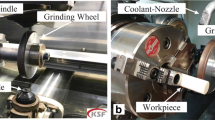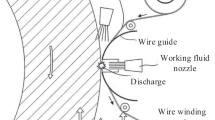Abstract
Expensive diamond grains remaining within waste diamond grinding wheels and wheel substrate need to be recycled. Electroplated diamond grinding wheel was taken as an example. An idea of “substrate structure-induced cracks (SSIC)” was proposed to solve the disassembly problem of waste electroplated diamond wheels. An assembled substrate for electroplated diamond grinding wheel was designed. Fabrication and disassembly experiments of electroplated diamond wheel with assembled substrate were carried out. Also, finite element analysis was used to investigate the mechanism of disassembly processes. Recycling experiments of electroplated diamond wheels were carried out in three ways, namely acid corrosion method, electrolysis method and SSIC method. The experimental results show that cracks generate in the diamond abrasive layer of the assembled wheel. The simulated maximum principal stress occurs on diamond abrasive layer near the mating surface between cylindrical pins and substrate, which is consistent with the location where the crack is created. The abrasive layer can be easily peeled off from substrate after the cracks occur on abrasive layer. Compared with electrolysis and acid corrosion methods, the SSIC method has the shortest disassembly time and the lowest disassembly costs. The assembled substrate provides possibility to exert cracking forces from substrate to diamond abrasive layer. With assembled substrate, the nondestructive disassembly of electroplated diamond wheel can be fulfilled. Assembled substrate can meet the need of DFD for electroplated diamond grinding wheel.










Similar content being viewed by others
References
Wang C, Wu Y, Bai L, Zhao Y, Yan Z, Jiang H, Liu X (2018) Recycling of drinking water treatment residue as an additional medium in columns for effective removal from eutrophic surface water. J Environ Manag 217:363–372
Ghazilla RAR, Sakundarini N, Taha Z, Abdul-Rashid SH, Yusoff S (2015) Design for environment and design for disassembly practices in Malaysia: a practitioner’s perspectives. J Clean Prod 108:331–342
Ajayi SO, Oyedele LO, Bilal M, Akinade OO, Alaka HA, Owolabi HA, Kadiri KO (2015) Waste effectiveness of the construction industry: understanding the impediments and requisites for improvements. Resour Conserv Recycl 102:101–112
Salama W (2017) Design of concrete buildings for disassembly: an explorative review. Int J Sustain Built Environ 6:617–635
Mukhanov VA, Filippov IM, Kovalenko VS (2017) Recovery of efficient abrasive powders from waste abrasive-oil suspensions—scraps of strip sawing. J Superhard Mater 32(2):124–127
Wang L, Zhang G, Ma F (2012) A study on comprehensive recycling of waste diamond tools. Rare Met 31(1):88–91
Skury ALD, Bobrovnitchii GS, Monteiro SN, Gomes CC (2004) Recovery of synthetic diamonds from scrapped sawblades. Sep Purif Technol 35:185–190
Mészáros M, Vadasdi K (1996) Process and equipment for electrochemical etching of diamond-containing Co-Wc tools and recovery of diamond from used steel tools. Int J Refract Met Hard Mater 14:229–234
Celep O, Aydin Karakurt (2012) Diamond recovery from waste sawblades: a preliminary investigation 2012. Proc IMechE B J Eng Manuf 227(6):917–921
Liu H, Hanyu H, Murakami Y, Kamiya S, Saka M (2001) Recycling technique for CVD diamond coated cutting tools. Surf Coat Technol 137:246–248
Zwolinski P, Lopez-Ontiveros MA, Brissaud D (2006) Integrated design of remanufacturable products based on product profiles. J Clean Prod 14:1333–1345
Hechler O, Larsen OP, Nielsen S (2011) Design for deconstruction. Waste Resour Manag 161(1):9–12
Rios FC, Chong WK, Grau D (2015) Design for disassembly and deconstruction—challenges and opportunities. Procedia Eng 118:1296–1304
Soh SL, Ong SK, Nee AYC (2014) Design for disassembly for remanufacturing: methodology and technology. Procedia CIRP 15:407–412
Boothroyd G, Alting L (1992) Design for assembly and disassembly. Ann CIRP 41:625–636
Duflou JR, Willems B, Dewulf W (2006) Towards self-disassembling products Design solutions for economically feasible large-scale disassembly. In: Brissaud D, Tichkiewitch S, Zwolinski P (eds) Innovation in life cycle engineering and sustainable development. Springer, Dordrecht, pp 87–110
Hatcher GD, Ijomah WL, Windmill JFC (2011) Design for remanufacture: a literature review and future research needs. J Clean Prod 19:2004–2014
Acknowledgements
This study was supported by Zhejiang Provincial Natural Science Foundation of China (Grant No. LY15E050006). This study was also sponsored by K.C. Wong Magna Fund in Ningbo University.
Author information
Authors and Affiliations
Corresponding author
Additional information
Technical Editor: Lincoln Cardoso Brandao.
Publisher's Note
Springer Nature remains neutral with regard to jurisdictional claims in published maps and institutional affiliations.
Rights and permissions
About this article
Cite this article
Chen, Q., Yu, A., Wu, M. et al. Design of assembled substrate of electroplated diamond grinding wheel for disassembly of abrasive layer. J Braz. Soc. Mech. Sci. Eng. 41, 493 (2019). https://doi.org/10.1007/s40430-019-2008-0
Received:
Accepted:
Published:
DOI: https://doi.org/10.1007/s40430-019-2008-0




